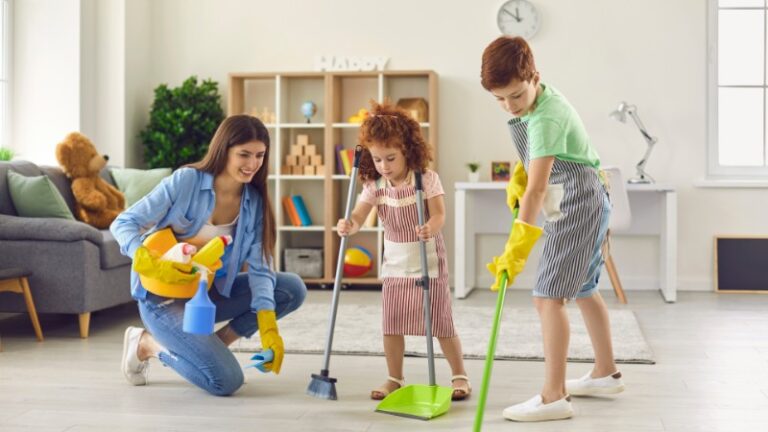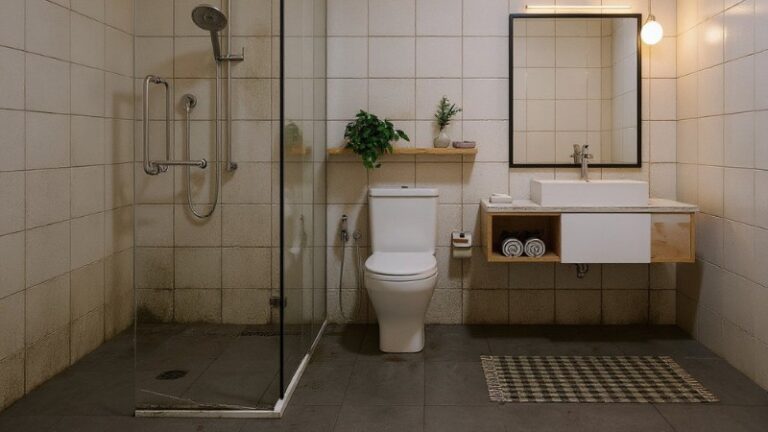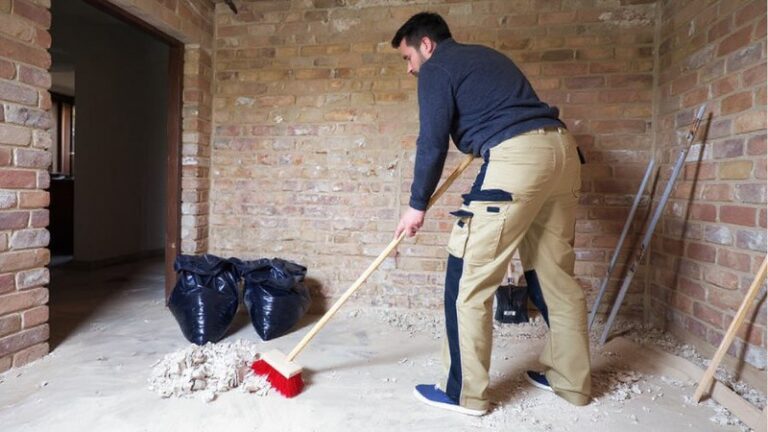It might seem like a quick shortcut to mix a few cleaning products together when tackling tough messes. Many people think combining different household cleaners or household chemicals can boost cleaning power and make chores easier. But the reality is far more dangerous.
When you start mixing bleach, vinegar, hydrogen peroxide, or other chemicals, you’re not creating a super cleaner you’re brewing a highly toxic chemical mixture that can release chlorine gas, burn your skin, or even harm your respiratory system. These harmful chemicals can lead to breathing problems, chest pain, watery eyes, and in extreme cases, even death.
Instead of risking exposure to dangerous chemicals or turning your home into a risky lab, it’s best to understand what cleaning products not to mix and keep your family safe.
Stick around as we reveal 15 dangerous cleaning product combinations you should never mix and learn safer, smarter ways to keep your space sparkling.
Content
- 1 15 Dangerous Cleaning Product Combinations to Avoid
- 1.1 1. Bleach and Vinegar
- 1.2 2. Bleach and Ammonia
- 1.3 3. Bleach and Rubbing Alcohol
- 1.4 4. Hydrogen Peroxide and Vinegar
- 1.5 5. Baking Soda and Vinegar
- 1.6 6. Different Drain Cleaners
- 1.7 7. Mildew Stain Remover and Bleach
- 1.8 8. Toilet Bowl Cleaner and Bleach
- 1.9 9. Vinegar and Castile Soap
- 1.10 10. Dish Detergent and Bleach
- 1.11 11. Lemon Juice and Bleach
- 1.12 12. Glass Cleaner and Bleach
- 1.13 13. Vinegar and Water on Wood Floors
- 1.14 14. Antibacterial/Disinfectants and Detergents
- 1.15 15. Oven Cleaner and Bleach
- 2 How to Use Cleaning Products Safely?
- 3 Keep It Clean — Without the Chemistry Experiment! Call Modern Maids
15 Dangerous Cleaning Product Combinations to Avoid
1. Bleach and Vinegar
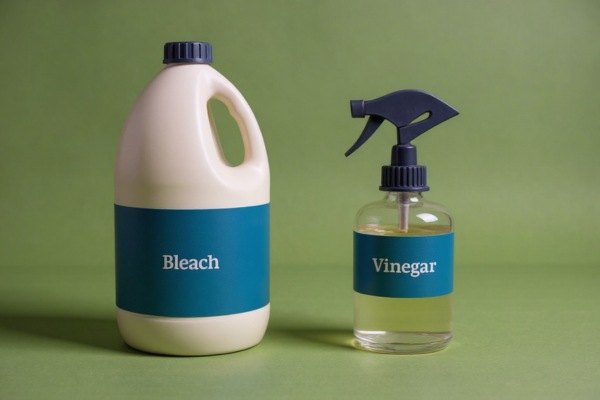
You might think combining bleach and vinegar could power up your cleaning game, especially when you’re facing stubborn mold or mildew in the bathroom. After all, both are strong household cleaners on their own. But mixing these two is one of the most dangerous chemical mixtures you can create at home.
When bleach and vinegar come together, they release chlorine gas, a highly toxic substance that can irritate or severely damage your respiratory system. Chlorine gas was even used as a weapon during World War I because of its harmful effects.
Just a small whiff can cause watery eyes, coughing fits, burning sensations in your nose and throat, and serious chest pain. Longer exposure might lead to lung injuries and, in extreme cases, even death.
It’s easy to make this mistake if you’re trying to scrub away tough grime in the shower or around sinks. Instead of mixing, choose one product. If you prefer a more natural approach, stick to vinegar.
If you need stronger disinfection, use chlorine bleach on its own. Always rinse thoroughly before switching to another cleaner to keep your family safe and avoid harmful chemicals.
2. Bleach and Ammonia
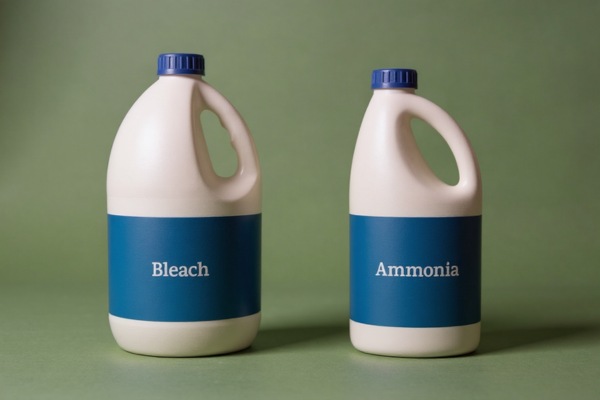
It’s tempting to reach for every cleaner under the sink when you’re trying to tackle tough grime on mirrors or bathroom floors. But mixing bleach with ammonia is one of the most dangerous mistakes you can make.
When these two strong household chemicals come together, they form chloramine gas. This gas isn’t just irritating, it’s highly toxic. Breathing it in can cause immediate chest pain, watery eyes, burning in your throat, and serious breathing problems.
In severe cases, people have ended up needing emergency care and even ventilation support.
Ammonia is a common ingredient in many glass and window cleaners, so it’s easy to accidentally mix it with bleach during deep cleaning sessions. Always take a moment to check product labels before using different cleaners in the same area.
To avoid dangerous chemicals and keep your family safe, stick to one product at a time. Rinse surfaces thoroughly before using something new, and make sure rooms stay well-ventilated. Being cautious today can prevent big health problems tomorrow.
3. Bleach and Rubbing Alcohol
Many people keep bleach and rubbing alcohol close by, thinking they’re a perfect tag team for fighting germs. It might feel like a smart way to double down on disinfecting, but combining these two creates a dangerous chemical mixture you definitely don’t want around your home.
When mixed, bleach and rubbing alcohol produce chloroform and hydrochloric acid. Chloroform isn’t just something you read about in crime novels in real life, it can cause dizziness, headaches, nausea, and even lead to fainting if inhaled in large amounts.
Hydrochloric acid is equally harmful, potentially damaging surfaces and releasing other toxic substances into the air.
Rather than risking harmful chemicals or harming your respiratory system, choose one product at a time. Isopropyl alcohol alone is a powerful disinfectant when used correctly. Just make sure to keep bleach stored away and avoid overlapping these strong household cleaners.
4. Hydrogen Peroxide and Vinegar
Many homeowners like to keep hydrogen peroxide and vinegar on hand because they seem like gentle, go-to staples for everyday messes. While each works well on its own, mixing them together is a different story.
When combined in the same container, these household products create peracetic acid. This highly reactive acid isn’t something you want floating around your kitchen or bathroom. It can irritate your skin, sting your eyes, and make breathing uncomfortable.
Even surfaces aren’t safe. Peracetic acid can dull the shine on counters, wear down tiles, and ruin finishes before you even realize it.
Instead of chasing a quick fix, it’s smarter to choose one product and finish the job completely before using another. Keeping them separate prevents harmful reactions and helps you avoid damaging your home.
5. Baking Soda and Vinegar
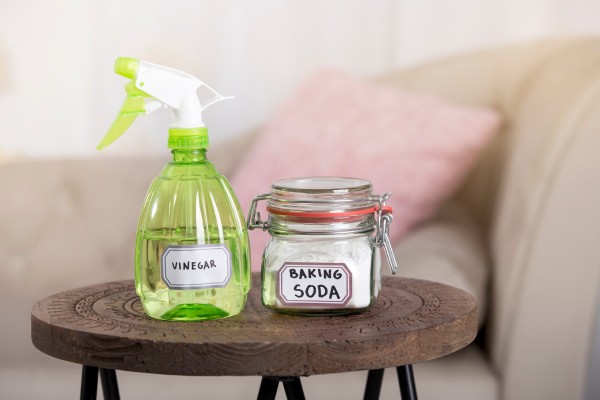
It’s easy to see why baking soda and vinegar have become favorites in so many homes. They feel safe, natural, and even fun to watch when they fizz up. But despite their popularity, mixing these two household products isn’t as magical as social media might suggest.
When combined, baking soda and vinegar cancel each other out. One is basic, the other is acidic, so instead of tackling stains or tough odors, they simply fizzle away into a weak solution that doesn’t do much cleaning at all.
On top of that, if you seal them in a closed container, the gas buildup from the reaction can create enough pressure to burst open, creating an unexpected and messy surprise.
The good news? You can still make the most of them, just not at the same time. For example, sprinkle baking soda on your sink or tub and scrub it down first. Rinse thoroughly, then follow up with vinegar to help break down leftover grime and freshen the surface.
6. Different Drain Cleaners
When a stubborn clog refuses to budge, it can be tempting to reach for every bottle under the sink and pour them all in at once. It might feel like cleaner means more power, but mixing different drain cleaners is one of the riskiest choices you can make.
Most drain cleaners contain harsh chemicals like sodium hydroxide, sulfuric acid, chlorine bleach, or hydrochloric acid. Each formula is designed to work on its own, and combining them can cause violent chemical reactions. This can lead to heat buildup, the release of toxic fumes, or in extreme cases, an explosive burst right from your pipes.
Instead of turning your pipes into a dangerous science experiment, stick to one drain cleaner at a time. After using it, flush the drain well with plenty of water and give it time before considering another option.
Being patient and careful with these powerful household chemicals keeps your plumbing safe and your family safe.
7. Mildew Stain Remover and Bleach
Battling mildew in the shower or on tiles can feel like a never-ending fight. When stubborn stains don’t budge, it might seem smart to grab both a mildew stain remover and bleach to get the job done faster. But this powerful-sounding combo is far from safe.
Many mildew removers include ammonia or other strong ingredients designed to break down mold. When you introduce bleach into the mix, these chemicals react and create harmful fumes that can quickly fill up even a well-ventilated bathroom.
Breathing in these toxic substances can lead to burning eyes, coughing, chest pain, and serious damage to your respiratory system.
If you’re determined to tackle mildew effectively, choose one cleaner and stick with it. Rinse surfaces completely before using any other household chemicals to avoid hidden reactions.
8. Toilet Bowl Cleaner and Bleach
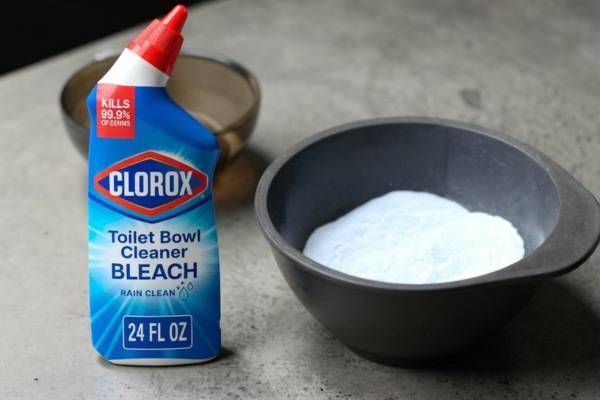
The toilet might be the last place you want to spend extra time, but mixing the wrong cleaners can turn a quick scrub into a serious health scare. Many people think that adding bleach to toilet bowl cleaner will leave the bowl extra fresh and sparkling. In reality, this move is more dangerous than helpful.
Most toilet bowl cleaners contain acids that break down stubborn rings and mineral stains. When these acids meet bleach, they don’t team up, they clash, creating chlorine gas in seconds. This gas can sting your eyes, make it hard to breathe, and leave you coughing uncontrollably.
Even a quick inhale can bring on watery eyes and chest tightness.
If you want a truly clean (and safe) toilet, stick to one cleaner at a time. Give it a good scrub, rinse everything thoroughly, and only then consider using another product if needed.
9. Vinegar and Castile Soap
Plenty of people love whipping up homemade cleaners, and vinegar and Castile soap often top the list of “natural” favorites. They both work beautifully on their own, so it might seem logical to combine them into one super spray. But in this case, more isn’t better, it’s messier.
When you mix acidic vinegar with Castile soap, the vinegar actually breaks the soap down into fatty acids. Instead of a smooth, effective cleaner, you end up with a greasy, curdled mess that leaves a film on counters, sinks, and floors.
Rather than lifting dirt, this mixture can make surfaces look streaky and feel sticky, forcing you to clean again just to fix it.
To get the best out of these household products, use Castile soap first to wash away grime, rinse well, and then follow up with vinegar if needed. Separating them keeps your surfaces truly clean and avoids unnecessary frustration.
10. Dish Detergent and Bleach
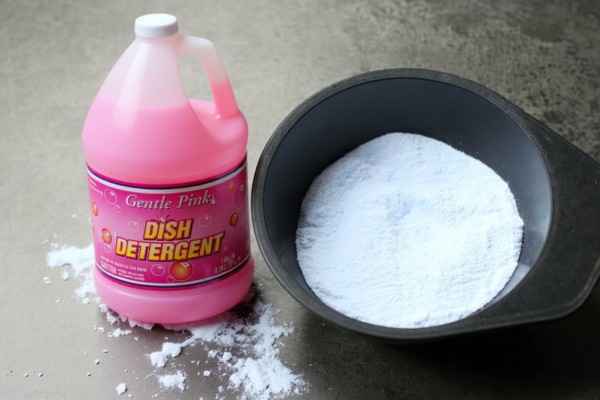
It’s easy to assume that adding a splash of bleach to your dish soap will supercharge your sink cleaning routine. After all, both are powerful on their own. But combining them isn’t just a waste it can put your health at serious risk.
Many dish detergents include ammonia or other active compounds to cut through grease. When these ingredients mix with bleach, they create chloramine vapors, which are highly toxic. Inhaling these fumes can lead to chest pain, coughing, watery eyes, and even breathing problems that need immediate medical attention.
Before adding anything extra to your dish soap, take a moment to read the label carefully. If it doesn’t clearly say that bleach is safe to mix, don’t risk it. Sticking to one product at a time keeps your kitchen family safe and helps you avoid harmful chemicals.
11. Lemon Juice and Bleach
Lemon juice feels like a bright, zesty solution for so many cleaning tasks. It smells fresh, cuts through grime, and leaves surfaces gleaming. But pairing it with bleach? That’s a fast track to creating a dangerous situation in your home.
When the acidic power of lemon juice meets bleach, it releases chlorine gas. Even a few drops mixed into a “DIY citrus cleaner” can create fumes strong enough to irritate your eyes, burn your throat, and cause serious breathing problems. In small, closed areas like kitchens or bathrooms, this gas can build up quickly and become highly toxic.
The safer choice? Use lemon juice on its own. It makes a fantastic natural deodorizer and works wonders on cutting boards, countertops, or sinks without involving harmful chemicals.
12. Glass Cleaner and Bleach
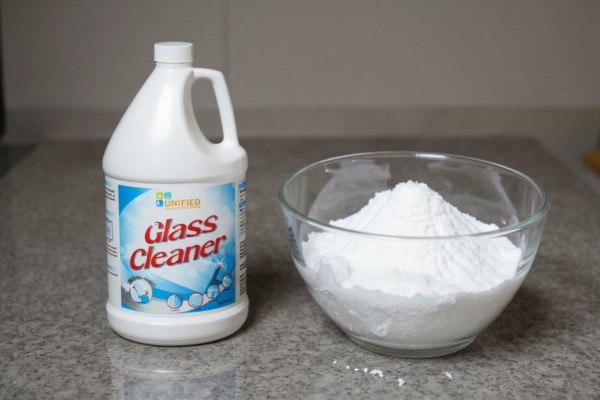
Reaching for the glass cleaner feels like an easy step to get mirrors and windows gleaming. But adding bleach into the mix doesn’t mean more sparkle it means more danger.
Most glass cleaners rely on ammonia to break down streaks and grime quickly. When bleach gets involved, it reacts with ammonia and forms chloramine gas, a substance so harsh it can leave you gasping for air in seconds. Small bathrooms or tight laundry areas make the situation even worse since there’s nowhere for these fumes to escape.
Instead of turning a simple wipe-down into a risky event, focus on using one product at a time. Wipe with your favorite glass cleaner, and leave the bleach in the cabinet where it belongs.
13. Vinegar and Water on Wood Floors
There’s something satisfying about using vinegar for an easy, natural clean. It feels simple, safe, and effective on countertops or glass. But when it comes to your beautiful wood floors, vinegar can quietly become their worst enemy.
The acidity in vinegar eats away at the protective finish that keeps wood floors looking rich and glossy. Over time, this breaks down the surface, dulls the natural shine, and can even damage the wood fibers underneath.
Plus, too much moisture from the mix can seep into the planks, leading to warping or long-term structural issues that cost more than a bucket of natural cleaner ever would.
For a safer, longer-lasting clean, choose a pH-neutral floor cleaner designed specifically for hardwood. These products protect the finish and keep your floors looking their best without the hidden risks.
14. Antibacterial/Disinfectants and Detergents
When you want to keep your home truly clean and family safe, it can feel tempting to mix everything under the sink to make surfaces extra spotless. But pairing antibacterial disinfectants with everyday detergents doesn’t double the protection it actually cuts it down.
Combining these household chemicals can deactivate the disinfecting power you’re counting on to kill germs. Instead of leaving a clean, sanitized surface, this chemical mixture may create sticky residues that attract even more dirt and leave behind streaks that look anything but fresh.
A better approach is to break it down into steps. Start by using your detergent or soap to remove dirt and grease first. Once you’ve rinsed and dried the area, follow up with your disinfectant to target harmful chemicals and toxic substances that can linger.
15. Oven Cleaner and Bleach
Cracking open the oven door can reveal a world of splatters and burnt bits that make you want to reach for the strongest products in sight. It might seem like combining oven cleaner with bleach would wipe away every last stain, but this risky mix is more trouble than it’s worth.
Oven cleaners are already loaded with powerful chemicals strong enough to break down thick, baked-on grease. Adding bleach to the equation doesn’t supercharge that cleaning power it creates a cloud of highly toxic fumes.
These corrosive gases can overwhelm you in seconds, especially when working inside the enclosed oven space.
Instead of turning cleaning day into a chemical hazard, stick to using oven cleaner exactly as directed. There’s no need to “boost” it with bleach or other dangerous chemicals.
How to Use Cleaning Products Safely?
Now that you know what cleaning products not to mix, it’s just as important to understand how to handle them properly. Using cleaning products the right way protects your respiratory system, keeps your family safe, and helps you avoid harmful chemicals that can cause unexpected health problems.
Before you grab that bottle, take a moment to slow down and read. Labels are there for a reason they guide you on how to use each product effectively and safely. Ignoring these instructions can lead to damaged surfaces, dangerous fumes, or even exposure to highly toxic substances.
Here are a few simple but powerful tips to keep in mind:
- Always read labels thoroughly and follow instructions for dilution, ventilation, and recommended surfaces.
- Never mix household chemicals to “experiment” with stronger results. Even small amounts can create dangerous chemicals like chlorine gas or peracetic acid.
- Use cleaning products in well-ventilated spaces to avoid breathing problems and reduce the risk of exposure to toxic substances.
- Wear gloves and eye protection when handling strong cleaners or other chemicals to prevent skin burns and irritation.
- Store household products in their original containers with clear labels so no one accidentally uses them the wrong way.
- Keep all household cleaners and dangerous chemicals out of reach of children and pets to maintain a safe family environment.
- Dispose of leftover products properly. Always check local guidelines before pouring anything down the drain, especially if it involves strong acids, hydrogen peroxide, or chlorine bleach.
Keep It Clean — Without the Chemistry Experiment! Call Modern Maids
Your home should feel like a fresh retreat, not a science lab gone wrong. Mixing the wrong cleaning products doesn’t lead to a cleaner space, it leads to harmful chemicals, breathing problems, and a whole lot of regret.
Why risk it when you can kick back and leave the hard work to the experts? At Modern Maids, we know what cleaning products not to mix and how to tackle every surface without creating toxic surprises. Our trusted team in Dallas and Austin is trained to handle even the toughest messes, so you can enjoy a sparkling home without lifting a finger or worrying about harmful fumes.
Ready to swap stress for spotless? Book your cleaning today or give us a call at (469)-430-8860. With Modern Maids, you get a fresh, shining space and total peace of mind no dangerous experiments required.


